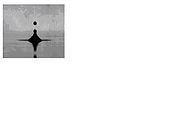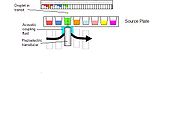
Acoustic droplet ejection
Encyclopedia

Litre
pic|200px|right|thumb|One litre is equivalent to this cubeEach side is 10 cm1 litre water = 1 kilogram water The litre is a metric system unit of volume equal to 1 cubic decimetre , to 1,000 cubic centimetres , and to 1/1,000 cubic metre...
. ADE technology is a very gentle process, and it can be used to transfer proteins, high molecular weight DNA and live cells without damage or loss of viability. This feature makes the technology suitable for a wide variety of applications including proteomics
Proteomics
Proteomics is the large-scale study of proteins, particularly their structures and functions. Proteins are vital parts of living organisms, as they are the main components of the physiological metabolic pathways of cells. The term "proteomics" was first coined in 1997 to make an analogy with...
and cell-based assays.
History
Acoustic droplet ejection was first reported in 1927 by Robert W. WoodRobert W. Wood
Robert Williams Wood was an American physicist and inventor. He is often cited as being a pivotal contributor to the field of optics and is best known for giving birth to the so-called "black-light effect"...
and Alfred Loomis
Alfred Lee Loomis
Alfred Lee Loomis was an American attorney, investment banker, philanthropist, scientist/physicist, pioneer in military radar usages, inventor of the LORAN or Long Range Navigation System, and lifelong patron of scientific research...
, who noted that when a high-power acoustic generator was immersed in an oil bath, a mound formed on the surface of the oil and, like a “miniature volcano,” ejected a continuous stream of droplets. Ripples that appear in a glass of water placed on a loud speaker show that acoustic energy can be converted to kinetic energy in a fluid. If the sound is turned up enough, droplets will jump from the liquid. This technique was refined in the 1970s and 1980s by Xerox
Xerox
Xerox Corporation is an American multinational document management corporation that produced and sells a range of color and black-and-white printers, multifunction systems, photo copiers, digital production printing presses, and related consulting services and supplies...
and IBM
IBM
International Business Machines Corporation or IBM is an American multinational technology and consulting corporation headquartered in Armonk, New York, United States. IBM manufactures and sells computer hardware and software, and it offers infrastructure, hosting and consulting services in areas...
and other organizations to provide a single droplet on-demand for printing ink onto a page. Two California-based companies, EDC Biosystems Inc. and Labcyte Inc., exploit acoustic energy for two separate functions: 1) as a liquid transfer device and 2) as a device for liquid auditing.
Ejection mechanism
To eject a droplet, a transducer generates and transfers acoustic energy to a source well. When the acoustic energy is focused near the surface of the liquid, a mound of liquid is formed and a droplet is ejected. [Figure 1] The diameter of the droplet scales inversely with the frequency of the acoustic energy—higher frequencies produce smaller droplets. Unlike other liquid transfer devices, no pipettePipette
A pipette is a laboratory tool used to transport a measured volume of liquid.-Use and variations:Pipettes are commonly used in molecular biology, analytical chemistry as well as medical tests...
tips, pin tools, or nozzle
Nozzle
A nozzle is a device designed to control the direction or characteristics of a fluid flow as it exits an enclosed chamber or pipe via an orifice....
s touch the source liquid or destination surfaces. Liquid transfer methods that rely on droplet formation through an orifice, e.g., disposable tips or capillary nozzles, invariably lose precision as the transfer volume decreases. Touchless acoustic transfer provides a coefficient of variation
Coefficient of variation
In probability theory and statistics, the coefficient of variation is a normalized measure of dispersion of a probability distribution. It is also known as unitized risk or the variation coefficient. The absolute value of the CV is sometimes known as relative standard deviation , which is...
(CVs) that is significantly lower than other techniques and is independent of volume at the levels tested.

Applications of acoustic transfer
The following applications are among those that can benefit from the features of acoustic droplet ejection:- High throughput screening
- Microelectromechanical systemsMicroelectromechanical systemsMicroelectromechanical systems is the technology of very small mechanical devices driven by electricity; it merges at the nano-scale into nanoelectromechanical systems and nanotechnology...

